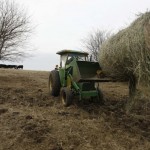NOBULL: Some feedlots, meatpackers closing after US ranchers sold off cattle amid widespread drought — AP
Some feedlots, meatpackers closing after US ranchers sold off cattle amid widespread drought
(Orlin Wagner/ Associated Press ) – In this Tuesday, Feb. 12, 2013 photograph, Randy Cree picks up a bale of hay while feeding cattle on his farm near Big Springs, Kan. Years of drought are reshaping the U.S. beef industry with feedlots and a major meatpacking plant closing because there are too few cattle left in the United States to support them.
By Associated Press, Updated: Sunday, February 24, 10:10 AM
WICHITA, Kan. — Years of drought are reshaping the U.S. beef industry with feedlots and a major meatpacking plant closing because there are too few cattle left in the United States to support them.
Some feedlots in the nation’s major cattle-producing states have already been dismantled, and others are sitting empty. Operators say they don’t expect a recovery anytime soon, with high feed prices, much of the country still in drought and a long time needed to rebuild herds.
The closures are the latest ripple in the shockwave the drought sent through rural communities. Most cattle in the U.S. are sent to feedlots for final fattening before slaughter. The dwindling number of animals also is hurting meatpackers, with their much larger workforces. For consumers, the impact will be felt in grocery and restaurant bills as a smaller meat supply means higher prices.
Owner Bob Podzemny has been taking apart the 32,000-head Union County Feed Yard near Clayton, N.M. It closed in 2009 when a bank shut off its operating capital in the midst of the financial crisis, and Podzemny said he doesn’t see reopening after struggling through Chapter 11 bankruptcy.
“There just are not that many cattle in this part of the country no more, and it is not profitable to bring them in and feed them, so it is shut down,” Podzemny said.
He’s now feeding a few cattle in another feedlot, buying them at about 450 pounds and growing them to 800 to 850 pounds. He then sells them to others who bring them to the typical 1,200- to 1,300-pound slaughter weight.
“It is making a little money now on just growing feeders and selling them as feeders rather than finishing them all the way out,” Podzemny said. “We do what we got to do to survive, you know.”
Cattle numbers have been falling for years as the price of corn used to feed animals in feedlots skyrocketed. The drought accelerated the process, but many feedlots were able to survive at first because ranchers whose pastures dried up weaned calves early and sent breeding cows to be fattened for slaughter.
But now far fewer livestock than normal remain on the farms. And, ironically, if it rains this spring and summer, even fewer animals will go into feedlots because ranchers will hold back cows to breed and rebuild their herds.
Texas, the largest beef-producing state, has been particularly hard hit with a historic drought in 2011 from which it still hasn’t fully recovered.
“Most of the bad news is in Texas,” said Dick Bretz, an Amarillo broker who specializes in selling feed yards and other agribusinesses. “That is where I see most of the empty yards, that is where I see most of the interest in selling yards and where I see the least interest in buying yards.”
He recently dismantled a 7,000-head feed yard in Hereford, Texas, for a new owner who had bought it for the land, not the business. The previous owner had lost the property to foreclosure, and the facility was in very poor condition and would have cost too much to repair, he said.
When corn prices first spiked to $8 a bushel nearly four years ago, about 70 big feed yards went up for sale in the High Plains feeding area that includes Texas, Kansas, Colorado and Nebraska, Bretz said. Today, there are 10 and 15 feed yards for sale in the region, mostly in Texas. Bretz said he knows of 15 more that are empty, three recently dismantled and two others now being torn down.
